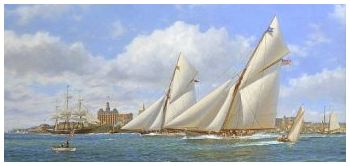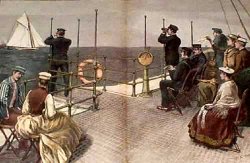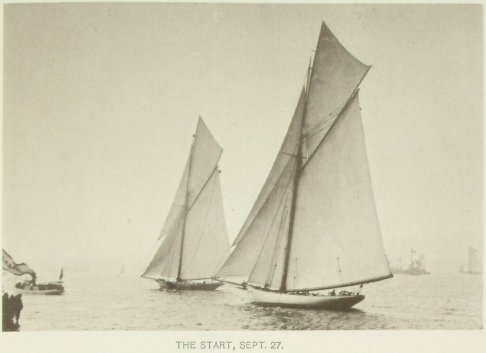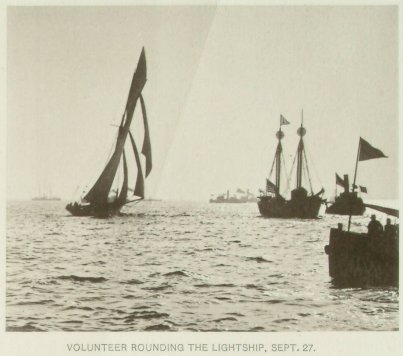Yves GARY Hits: 6327
Category: 1887 : CHALLENGE N°7
 Two out of three races were decided upon for the international series, one over the inside course, one to windward and return outside Sandy Hook, and the third, if necessary, triangular, over an outside course. The date set for the first race was September 27th.
Two out of three races were decided upon for the international series, one over the inside course, one to windward and return outside Sandy Hook, and the third, if necessary, triangular, over an outside course. The date set for the first race was September 27th.
The first of the great Cup races of 1887 occurred on Tuesday, September 27, and was sailed over the inside course. The inside course was to be sailed over for the last time, it proved, in an international match. It was a bad course at best, and a source of hot anger and fierce discontent to British skippers.
 The excitement over the event was even greater than that over the two previous contests for the Cup, and there was a strong feeling of doubt as to the result, owing to the splendid record of the Thistle and to the secrecy in regard to her model.It was a struggle between the fleetest yachts which Great Britain and America had ever produced, and the hundreds of steam and sailing craft which were massed about the starting-point, ready to chase the racers, formed a picture which was beautiful in the extreme. The contest was closely followed, not only by the people of this country, who eagerly watched the bulletins of the race, but by the people all over the British Isles, where the excitement ran high. The Thistle had shown that she was best adapted to a light wind, and, as that was the kind of a breeze in which the race was started, a close contest was looked for.
The excitement over the event was even greater than that over the two previous contests for the Cup, and there was a strong feeling of doubt as to the result, owing to the splendid record of the Thistle and to the secrecy in regard to her model.It was a struggle between the fleetest yachts which Great Britain and America had ever produced, and the hundreds of steam and sailing craft which were massed about the starting-point, ready to chase the racers, formed a picture which was beautiful in the extreme. The contest was closely followed, not only by the people of this country, who eagerly watched the bulletins of the race, but by the people all over the British Isles, where the excitement ran high. The Thistle had shown that she was best adapted to a light wind, and, as that was the kind of a breeze in which the race was started, a close contest was looked for.
 After waiting two hours for the wind to freshen, the first signal gun was fired at 12:20 o'clock, and the racers, with main-sails, club-top-sails, forestay-sails, jibs, and jib-top-sails set, played about the line, each trying to secure the more advantageous position. The Thistle was the first to cross, at 12:33:06, and went over on the port tack, close up to the windward end of the line, — the wind then being light from the southward. The Volunteer followed directly in her wake, and crossed on the same tack at 12:34:58 o'clock. The moment the beautiful white sloop crossed she began to close up the gap of five hundred feet which existed between them, and as she overhauled her rival cheer after cheer burst from the thousands of spectators. The Thistle was being held close to the wind, but just before the Volunteer reached her she went about on the starboard tack and headed for the Bay Ridge shore. The Thistle's skipper evidently believed that the Volunteer would blanket him, and he made the tack, in the hope that the sloop would follow him and thus be under his lee. The Volunteer, however, kept on her course. On this tack the Thistle drew out of the wind and into the strong tide, and as the Volunteer was holding the breeze well, the cutter again went about and stood over toward her.
After waiting two hours for the wind to freshen, the first signal gun was fired at 12:20 o'clock, and the racers, with main-sails, club-top-sails, forestay-sails, jibs, and jib-top-sails set, played about the line, each trying to secure the more advantageous position. The Thistle was the first to cross, at 12:33:06, and went over on the port tack, close up to the windward end of the line, — the wind then being light from the southward. The Volunteer followed directly in her wake, and crossed on the same tack at 12:34:58 o'clock. The moment the beautiful white sloop crossed she began to close up the gap of five hundred feet which existed between them, and as she overhauled her rival cheer after cheer burst from the thousands of spectators. The Thistle was being held close to the wind, but just before the Volunteer reached her she went about on the starboard tack and headed for the Bay Ridge shore. The Thistle's skipper evidently believed that the Volunteer would blanket him, and he made the tack, in the hope that the sloop would follow him and thus be under his lee. The Volunteer, however, kept on her course. On this tack the Thistle drew out of the wind and into the strong tide, and as the Volunteer was holding the breeze well, the cutter again went about and stood over toward her.
 At 12:47 o'clock the Volunteer tacked to starboard, crossed the Thistle's bow, and held the weather position. It was a move which served to firmly fix the belief in the sloop, and it was heartily applauded. The Volunteer now seemed to get a stronger breeze and increased her pace, while the Thistle sailed lazily, and with her sails hardly filled. At half an hour from the start the Volunteer had a lead of more than an eighth of a mile, and at buoy 13 she was fully a half-mile to the fore. Not only was she drawing- away, but she was pointing higher into the wind than the cutter. For a short time after this the wind shifted and decreased somewhat in force, both boats faring alike; but it soon increased, and the Volunteer was the first to get the benefit. At buoy 10 the sloop led the cutter by over a mile, and was much farther to windward. She passed the buoy at 2:21:03, and the Thistle did not round until 2:36:45 o'clock.
At 12:47 o'clock the Volunteer tacked to starboard, crossed the Thistle's bow, and held the weather position. It was a move which served to firmly fix the belief in the sloop, and it was heartily applauded. The Volunteer now seemed to get a stronger breeze and increased her pace, while the Thistle sailed lazily, and with her sails hardly filled. At half an hour from the start the Volunteer had a lead of more than an eighth of a mile, and at buoy 13 she was fully a half-mile to the fore. Not only was she drawing- away, but she was pointing higher into the wind than the cutter. For a short time after this the wind shifted and decreased somewhat in force, both boats faring alike; but it soon increased, and the Volunteer was the first to get the benefit. At buoy 10 the sloop led the cutter by over a mile, and was much farther to windward. She passed the buoy at 2:21:03, and the Thistle did not round until 2:36:45 o'clock.
The second quarter of the course — from buoy 8 to the Sandy Hook Lightship — was a reach of about ten miles, and the Volunteer made it on a long starboard tack. She rounded the lightship at 3:42:12, having added over three minutes to her lead since leaving buoy 10. She made a splendid homeward run, meeting the Thistle about a mile and a quarter from the lightship. The latter was rounded by the Scotch boat at 4:01:15 o'clock. At buoy 8, the Volunteer broke out her spinnaker, and proudly sailed up the last stretch of the course, with the grandest convoy of steam vessels that ever accompanied a yacht.
The finish line was reached at 5:28:16 o'clock, and then there arose a din of congratulation which could not be excelled. The Thistle's homeward run was her best work of the day. Under her enormous silk spinnaker, which almost hid her hull, she gained one minute and twenty-six seconds on the Volunteer, from the lightship to the finish line. She was a badly-beaten boat, but the demonstration in her honor, at the end of the race, was as grand as the one to the victor.
Course. — 38 miles ; New York Yacht Club inside course.
Wind. — Average force about 8 knots an hour ; south at the start, then west, backing to south-west during the first half of the race, and south-east during the remainder.

The Volunteer defeated the Thistle by 19 minutes 23 1 seconds, corrected time. The Volunteer allowed the Thistle 5 seconds.
On Thursday, September 29, the day set for the second race, the wind was so light that the yachts did not start.
The Second Race was sailed on September 30, the course being twenty miles to windward, starting from the Scotland Lightship, and back to the starting-point. The wind was east by north, blowing at the rate of twelve knots an hour, and as it was raining, and there was a good sea on, the yachts had a line opportunity to show their abilities in heavy weather.
 The manoeuvres for position at the start resulted in the Volunteer getting the advantage. The Thistle went over the line at 10: 40: 21, and the Volunteer at 10: 40: 50 1 , the latter being on the weather quarter of the cutter. The outer mark-boat was stationed east by north, twenty miles distant, and both yachts started off for it on the starboard tack. With sails trimmed flat and rigid as boards, the yachts rushed almost bow and bow through five or six miles of the heavy sea, and made a beautiful race. They were both jammed close to the wind, but the Volunteer could hold herself higher than her rival, and during this tack she crept foot by foot to windward of the Scotch boat, although not outfooting her.
The manoeuvres for position at the start resulted in the Volunteer getting the advantage. The Thistle went over the line at 10: 40: 21, and the Volunteer at 10: 40: 50 1 , the latter being on the weather quarter of the cutter. The outer mark-boat was stationed east by north, twenty miles distant, and both yachts started off for it on the starboard tack. With sails trimmed flat and rigid as boards, the yachts rushed almost bow and bow through five or six miles of the heavy sea, and made a beautiful race. They were both jammed close to the wind, but the Volunteer could hold herself higher than her rival, and during this tack she crept foot by foot to windward of the Scotch boat, although not outfooting her.
At 11.48 o'clock the Thistle went about on the port tack, she then being well in toward the Long Island shore. The Volunteer continued on her course, and crossed the bows of the cutter with fully five minutes to spare. Such was her gain in the first hour and a quarter of the race. The sloop tacked to port at 1:51:40 o'clock, and both stood off on this tack for an hour, during which the Boston boat continued to draw up to windward more than did the visitor. The Thistle went about on the starboard tack at 12.51, and the Volunteer followed at 1.10 o'clock. Fifteen minutes later the latter set her club-top-sail over the gaff-top-sail and soon split tacks, standing out to sea, while the Thistle kept on along the shore. But one more tack was necessary, and the sloop accordingly, at 2.20 o'clock, tacked to starboard, and began her run to weather the outer mark-boat, which was a mile away. She rounded the mark at 2: 20: 40 o'clock, and it was not until 2.41 o'clock that the Thistle reached the same point. The Volunteer had beaten the Thistle nearly fifteen minutes in their twenty-mile race to windward.
The sloop's spinnaker was set with fjreat caution, and she was soon bowling along with that and her main-sail, club-top-sail, and balloon jib-top-sail. Immediately after rounding, the Thistle's balloon jib-top-sail and spinnaker were set, the latter, as was the Volunteer's, being to port. Here the cutter showed her running powers, and went along at a pace which was faster than the sloop's, although she could not overhaul the latter. In the run of twenty miles before the wind, her gain was two minutes fifty-four and one-half seconds. When four miles from the finish line the Thistle took in her spinnaker ; the Volunteer, a mile ahead, also taking in hers at the same time. In these relative positions the racers bore down on the lightship, both being on the port tack.
The Volunteer crossed the line at 4:23:47, and the Thistle at 4:35:12 o'clock. The Boston sloop had won the race, and was proclaimed the winner of the America's Cup, while cannons and steam whistles rent the air, and cheer after cheer added to the tumult.

